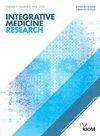针灸治疗癌症相关性失眠:证据图谱
IF 3
4区 医学
Q2 INTEGRATIVE & COMPLEMENTARY MEDICINE
引用次数: 0
摘要
针灸在治疗癌症相关性失眠(CRI)方面显示出前景;然而,其有效性的证据水平仍然很低。本研究系统地检查了研究质量,并使用证据制图(EM)来绘制和呈现证据信息,以确定差距并为未来的研究提供信息。方法2位审稿人检索了8个数据库,从数据库建立至2024年5月,筛选符合条件的随机对照试验(rct),并从纳入的研究中提取关键特征。使用Cochrane风险偏倚2.0 (RoB 2.0)工具评估研究质量,并将关键特征可视化EM。最后,对穴位数据进行系统总结。结果共纳入37项随机对照试验。RoB 2.0的结果显示只有三个研究是“低风险”的,而大多数研究都有明显的质量问题。EM显示,常见的比较包括手动针灸(MA),单独或联合,与睡眠药物。测量包括六种评估工具,其中最常用的是匹兹堡睡眠质量指数(PSQI)。同时,EM显示针刺对CRI的疗效有相当大的不确定性。穴位分析确定银堂(GV24+)、神庭(GV24)、百会(GV20)、三阴角(SP6)、内关(PC6)、神门(HT7)为核心穴位。分析确定了五个关键差距:研究可靠性、参与者选择、安慰剂效应、结果测量和穴位选择。结论针刺治疗CRI的研究存在诸多空白,需要更多高质量的证据。本研究全面梳理了针刺治疗急性脑损伤的现有证据,并确定了五个关键空白,为今后的研究提供了方向和参考。协议注册INPLASY202460052。本文章由计算机程序翻译,如有差异,请以英文原文为准。
Acupuncture for cancer-related insomnia: An evidence mapping
Background
Acupuncture shows promise in treating cancer-related insomnia (CRI); however, the evidence level for its effectiveness remains low. This study systematically examined research quality and used evidence mapping (EM) to map and present evidence information to identify gaps and inform future research.
Methods
Two reviewers searched eight databases from inception to May 2024, screened eligible randomized controlled trials (RCTs), and extracted key characteristics from included studies. The quality of studies was assessed using the Cochrane Risk of Bias 2.0 (RoB 2.0) tool, and key characteristics visualized EM. Finally, Acupoint data were systematically summarized.
Results
37 RCTs were included in this study. RoB 2.0 results showed only three studies at "low risk," while most had notable quality issues. EM indicated that common comparisons involved manual acupuncture (MA), alone or combined, versus sleep medications. Measures involved six assessment tools, with Pittsburgh Sleep Quality Index (PSQI) most frequently used. Meanwhile, EM revealed considerable uncertainty regarding acupuncture for CRI efficacy. Acupoint analysis identified Yintang (GV24+), Shenting (GV24), Baihui (GV20), Sanyinjiao (SP6), Neiguan (PC6), and Shenmen (HT7) as core acupoints. Analysis identified five key gaps: study reliability, participant selection, placebo effect, outcome measurement, and acupoint selection.
Conclusions
Research on acupuncture for CRI has various gaps, and more high-quality evidence is still needed. This study comprehensively mapped the current evidence on acupuncture for CRI and identified five key gaps, providing directions and references for future research.
Protocol registration
INPLASY, INPLASY202460052.
求助全文
通过发布文献求助,成功后即可免费获取论文全文。
去求助
来源期刊

Integrative Medicine Research
Medicine-Complementary and Alternative Medicine
CiteScore
6.50
自引率
2.90%
发文量
65
审稿时长
12 weeks
期刊介绍:
Integrative Medicine Research (IMR) is a quarterly, peer-reviewed journal focused on scientific research for integrative medicine including traditional medicine (emphasis on acupuncture and herbal medicine), complementary and alternative medicine, and systems medicine. The journal includes papers on basic research, clinical research, methodology, theory, computational analysis and modelling, topical reviews, medical history, education and policy based on physiology, pathology, diagnosis and the systems approach in the field of integrative medicine.
 求助内容:
求助内容: 应助结果提醒方式:
应助结果提醒方式:


